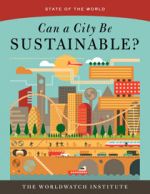State of the World: Can a City Be Sustainable?

This Worldwatch Institute publication suggests some different directions for more sustainable cities. Sustainability is framed in an all-encompassing way. While much of the book discusses responses to climate challenges, space is also given to social justice consideration.
For instance, one chapter addresses how urban planning and design can foster social integration. This chapter points out the problems of urban stratification, which are hard to ignore: “More than two-thirds of the urban population lives in cities where the income gap has widened sharply in the past three decades” (page 320). This inequality is a feature of countries across the income spectrum; the cities that have crossed the UN’s international alert line for income inequality include Hong Kong and, notably, Johannesburg. While the factors contributing to such inequality are numerous – globalization, reduced social expenditure, liberalization, and many more – there are some all-too-common impacts: reduced social cohesion and increased insecurity.
The authors contend that local-level measures have an important role to play in combatting social exclusion, which includes ensuring that national policies are implemented locally in holistic and participatory ways. They recommend more balanced land-use planning, particularly to leave capacity in city-owned land to deal with future crises; integrating land-use and transport planning with mixed uses; upgrading street networks that connect underserved parts of cities, especially informal settlements, to economically stronger ones; and carefully designing public spaces that allow for mixed groups to interact.
Showing the book’s breadth, other chapters are dedicated to:
· Sprawl
· Urban greenhouse gas emissions
· Energy
· Transport
· Waste
· Migration
· Biodiversity
· Remunicipalization
The book’s suggestions are context-dependent, and inspiration comes in the form of “city view” profiles, which contextualize thematic chapters with examples of sustainability efforts around the world. For example, the city view on Durban, South Africa outlines that city’s municipal and community adaptation initiatives, from public works projects to the mobilizing of the “treepreneurs” who gather native seeds and plant these species. These city views provide examples of how urban leadership is reducing the sustainability deficit – and how other cities can push their own efforts further.
Further reading:
Environment and Urbanization (1998), “Sustainable cities revisited”, Vol 10, No 2, available at http://eau.sagepub.com/content/10/2.
Kenworthy, Jeffrey R (2006), “The eco-city: ten key transport and planning dimensions for sustainable city development”, Environment and Urbanization Vol 18, No 1, pages 67–85, available at http://eau.sagepub.com/content/18/1/67.abstract.
UN-Habitat (2013), Streets as Public Spaces and Drivers of Urban Sustainability, 152 pages, available at http://unhabitat.org/books/streets-as-public-spaces-and-drivers-of-urban-prosperity/.
Book note prepared by Christine Ro
Search the Book notes database
Our Book notes database contains details and summaries of all the publications included in Book notes since 1993 - with details on how to obtain/download.
Use the search form above, or visit the Book notes landing page for more options and latest content.
For a searchable database for papers in Environment and Urbanization, go to http://eau.sagepub.com/

